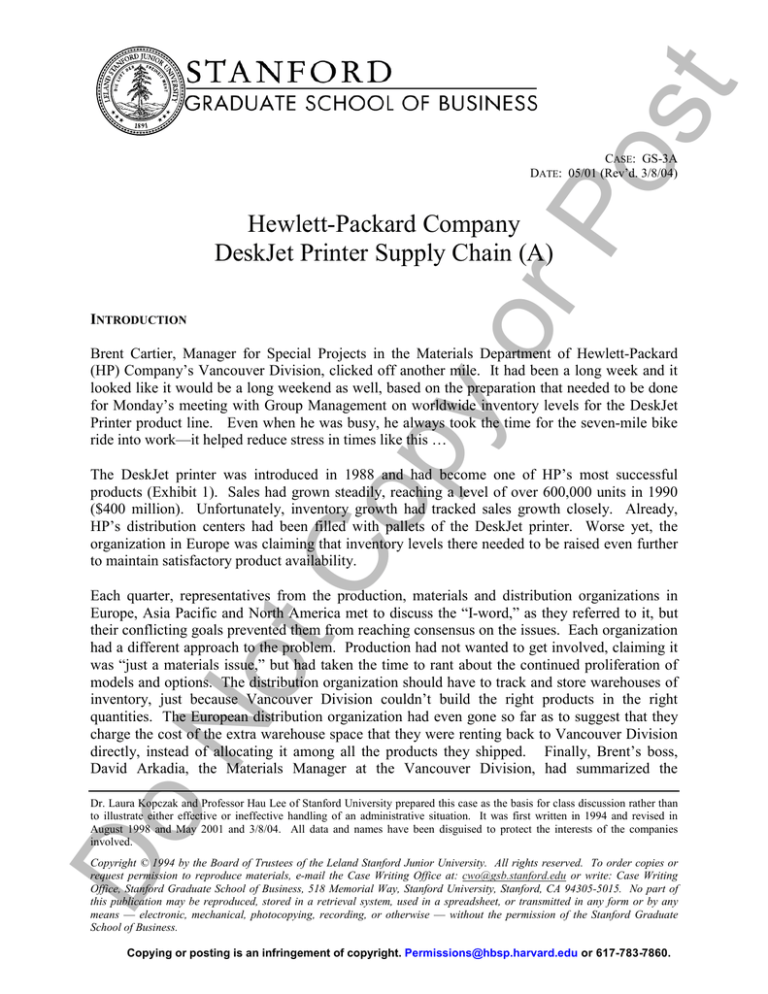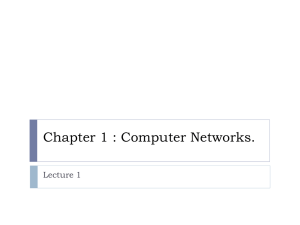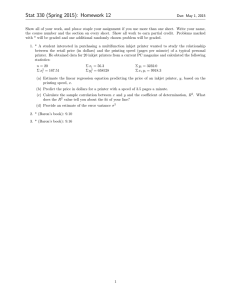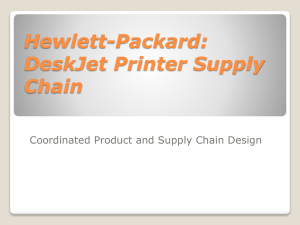
os
t
rP
CASE: GS-3A
DATE: 05/01 (Rev’d. 3/8/04)
Hewlett-Packard Company
DeskJet Printer Supply Chain (A)
yo
INTRODUCTION
op
Brent Cartier, Manager for Special Projects in the Materials Department of Hewlett-Packard
(HP) Company’s Vancouver Division, clicked off another mile. It had been a long week and it
looked like it would be a long weekend as well, based on the preparation that needed to be done
for Monday’s meeting with Group Management on worldwide inventory levels for the DeskJet
Printer product line. Even when he was busy, he always took the time for the seven-mile bike
ride into work—it helped reduce stress in times like this …
No
tC
The DeskJet printer was introduced in 1988 and had become one of HP’s most successful
products (Exhibit 1). Sales had grown steadily, reaching a level of over 600,000 units in 1990
($400 million). Unfortunately, inventory growth had tracked sales growth closely. Already,
HP’s distribution centers had been filled with pallets of the DeskJet printer. Worse yet, the
organization in Europe was claiming that inventory levels there needed to be raised even further
to maintain satisfactory product availability.
Each quarter, representatives from the production, materials and distribution organizations in
Europe, Asia Pacific and North America met to discuss the “I-word,” as they referred to it, but
their conflicting goals prevented them from reaching consensus on the issues. Each organization
had a different approach to the problem. Production had not wanted to get involved, claiming it
was “just a materials issue,” but had taken the time to rant about the continued proliferation of
models and options. The distribution organization should have to track and store warehouses of
inventory, just because Vancouver Division couldn’t build the right products in the right
quantities. The European distribution organization had even gone so far as to suggest that they
charge the cost of the extra warehouse space that they were renting back to Vancouver Division
directly, instead of allocating it among all the products they shipped. Finally, Brent’s boss,
David Arkadia, the Materials Manager at the Vancouver Division, had summarized the
Do
Dr. Laura Kopczak and Professor Hau Lee of Stanford University prepared this case as the basis for class discussion rather than
to illustrate either effective or ineffective handling of an administrative situation. It was first written in 1994 and revised in
August 1998 and May 2001 and 3/8/04. All data and names have been disguised to protect the interests of the companies
involved.
Copyright © 1994 by the Board of Trustees of the Leland Stanford Junior University. All rights reserved. To order copies or
request permission to reproduce materials, e-mail the Case Writing Office at: cwo@gsb.stanford.edu or write: Case Writing
Office, Stanford Graduate School of Business, 518 Memorial Way, Stanford University, Stanford, CA 94305-5015. No part of
this publication may be reproduced, stored in a retrieval system, used in a spreadsheet, or transmitted in any form or by any
means –– electronic, mechanical, photocopying, recording, or otherwise –– without the permission of the Stanford Graduate
School of Business.
Copying or posting is an infringement of copyright. Permissions@hbsp.harvard.edu or 617-783-7860.
GS-3A
p. 2
os
t
HP DeskJet Printer Supply Chain
perspective of Group Management at the last meeting when he said, “The word is coming down
from corporate: We can’t run our business with this level of unproductive assets. We’re just
going to have to meet customer needs with less inventory.”
yo
rP
As Brent saw it, there were two main issues. The first issue was to find the best way to satisfy
customer needs in terms of product availability while minimizing inventory. The second and
stickier issue involved how to get agreement among the various parties that they had the right
level of inventory. They needed to develop a consistent method for setting and implementing
inventory goals and get everyone to sign off on it and use it. It was not going to be easy. The
situation was especially urgent in Europe. His mind was still filled with the faxed picture that he
had received the previous day, showing the dip in product availability levels for some versions of
the product at the European Distribution Center (DC), yet he was sure that loads and loads of
DeskJets has been shipped to Europe in the past months. His voicemail had been filled with
angry messages from the sales offices, and yet the European DC was telling Vancouver that they
had run out of space to store Vancouver’s products.
BACKGROUND
op
Brent parked his bike and headed for the company showers. His morning shower was another
ritual—this was the time he had to review his plans for the day and play out different scenarios.
Perhaps a solution would come to him.
No
tC
Hewlett-Packard Company was founded in 1939 by William Hewlett and David Packard, with
headquarters in Palo Alto, California. It grew steadily over the next fifty years, diversifying
from its base in electronic test and measurement equipment into computers and peripherals
products, which now dominated its sales. In 1990 HP had over 50 operations worldwide, with
revenues of $13.2 billion and net income of $739 million.
Hewlett-Packard was organized partially by product group and partially by function. The
Peripherals Group was the second largest of HP’s six product groups, with 1990 revenues of $4.1
billion. The group’s divisions each acted as a Strategic Business Unit for a specific set of
products. Products included printers, plotters, magnetic disc and tape drives, terminals and
network products.
Do
The Peripherals Group had set technological standards with many of its products, with
innovations such as the disposable print head used in its inkjet printers and moving-paper
plotters. While these innovations contributed to its success, the Peripherals Group was also
recognized for its ability to identify and profitably exploit market opportunities, as in the case of
its most successful product, the LaserJet printer.
The Retail Printer Market
Worldwide sales of small workgroup/personal printers in 1990 were about 17 million units,
amounting to $10 billion. The market tracked personal computer sales closely; the market was
Copying or posting is an infringement of copyright. Permissions@hbsp.harvard.edu or 617-783-7860.
GS-3A
p. 3
os
t
HP DeskJet Printer Supply Chain
mature in the US and Western Europe but was still developing in Eastern Europe and in the
Asia-Pacific region.
rP
Small workgroup/personal printers were sold almost exclusively through resellers. The reseller
channels were changing rapidly, particularly in the US. Traditionally, printers had been sold
through computer dealers, but as personal computers became commodity products, more and
more sales were flowing through superstores and consumer mass merchandisers such as K-Mart
and Price Club.
yo
The retail printer market was composed of three technology segments: impact/dot matrix (40%),
inkjet (20%) and laser (40%). Dot matrix was the oldest technology, and was viewed as noisy
and of lower print quality compared to the other two types. The dot matrix printer market share
was expected to fall to 10% during the next few years as the technology was replaced by either
inkjet or laser printers in all applications except multi-part forms and wide carriage printing.
Prior to 1989, most customers were not aware of inkjet technology. However, customers were
discovering that inkjet print quality was almost as good as laser print quality at a much more
affordable price. Sales had increased dramatically. In the monochrome market, it remained to
be seen which technology would eventually dominate at the low end. Much would depend on the
pace at which technology developed in both areas, and the relative costs.
op
HP and Canon separately pioneered inkjet technology at their respective corporate laboratories
during the early 1980s. The key technological breakthroughs had been ink formulation and the
disposable print head. HP had introduced its first disposable head model, the ThinkJet printer, in
the late 1980s, while Canon had just introduced one in 1990.
No
tC
HP led the inkjet market in the US, while Canon led the market in Japan. European competitors
included Epson, Manisman-Tally, Siemens’ and Olivetti, though only Olivetti had introduced a
printer with a disposable print head by 1991. Some dot matrix printer companies were also
starting to offer inkjet printer products.
Inkjet printers were rapidly becoming commodity products. The end customer, choosing
between two inkjet printers of equal speed and print quality, increasingly used general business
criteria such as cost, reliability, quality and availability to decide. Product loyalty continued to
decrease.
The Vancouver Division and its Quest for Zero Inventory
Do
In 1990, Vancouver Division’s mission statement read: “Our Mission is to Become the
Recognized World Leader in Low Cost Premium Quality Printers for Printed Communications
by Business Personal Computer Users in Offices and Homes.”
The Vancouver Division, located in Vancouver, Washington, was established in 1979. HP saw
an opportunity to provide personal printers for the relatively new, fast-growing personal
computer market. HP consolidated personal printer activities from four divisions (Fort Collins,
Colorado; Boise, Idaho; Sunnyvale, California; Corvallis, Oregon) to the Vancouver site. The
Copying or posting is an infringement of copyright. Permissions@hbsp.harvard.edu or 617-783-7860.
GS-3A
p. 4
os
t
HP DeskJet Printer Supply Chain
new division became part of HP’s Peripherals Group and was chartered with the design and
manufacturing of inkjet printers.
rP
As Bob Foucoult, the production manager and one of Vancouver’s first employees recalled,
“Management was pulled from all over HP and plopped down in Vancouver. There was no
cohesive staff and no cohesive set of business practices—perhaps that’s why we were so open to
new ideas.”
yo
The manufacturing organization realized early on that a fast, high-volume process would be
required for success in the printer market. With the current (1979) 8–12 week cycle time and 3.5
months of inventory, the Vancouver Division would be doomed to fail. They looked within HP
for knowledge of high-volume processes, but found none. HP, being an instrument company,
only had experience building low volume, highly customized products using batch processes.
op
One day in mid-1981 two Vancouver managers happened to take seats on a plane next to two
professors—Richard Schoenberger (Nebraska University) and Robert Hall (Indiana University).
Schoenberger had just written a rough draft for a paper called “Driving the Productivity
Machine” about a manufacturing process being used in Japan: Kanban. Vancouver’s
management recognized the promise of this “new” manufacturing concept and Robert Hall
recognized an opportunity to have his ideas tested in the US. They decided to work together.
No
tC
Within a year Vancouver had converted the factory to stockless production and had reduced
inventory from 3.5 months to 0.9 months, with a drastic reduction in cycle time. Vancouver
became a showcase factory for the Kanban process; between 1982 and 1985 over 2,000
executives from within and outside HP toured the process. Vancouver impressed visitors by
having them sign a raw printed circuit board as they arrived, then presenting them with a finished
printer, made with that PC board using the standard process, an hour and a half later.
There was one key element missing, however. As Bob Foucoult puts it, “We were all dressed up
but had no one to take us to the dance.” Vancouver had not yet introduced a successful, highvolume product that would take full advantage of the advanced production line. Vancouver had
introduced products based on HP’s latest inkjet technology, but, as with any new technology,
they had to gain experience to work the bugs out. The early models had poor resolution and
required special paper for printing, resulting in limited success in the market place.
Do
In 1988, things started to change. Vancouver introduced the DeskJet printer, a new model with
near letter-quality resolution using standard paper. The introduction was a wild success. Since
the manufacturing process had been in place and had been thoroughly exercised, all that was
needed was to “flip the switch.” HP’s knowledge and implementation of the InkJet technology,
combined with its streamlined manufacturing process, gave HP the edge needed to become the
market leader in the inkjet printer market.
The DeskJet Supply Chain
Copying or posting is an infringement of copyright. Permissions@hbsp.harvard.edu or 617-783-7860.
GS-3A
p. 5
os
t
HP DeskJet Printer Supply Chain
rP
The network of suppliers, manufacturing sites, distribution centers (DCs), dealers and customers
for the DeskJet product comprised the DeskJet supply chain (Exhibit 2). Manufacturing was
done by HP in Vancouver. There were two key stages in the manufacturing process: (1) printed
circuit assembly and test (PCAT) and (2) final assembly and test (FAT). PCAT involved the
assembly and testing of electronic components like ASIC’s (application specific integrated
circuits), ROM (read-only-memory), and raw printed circuit boards to make logic boards and
print head driver boards for the printers. FAT involved the assembly of other subassemblies like
motors, cables, key pads, plastic chassis and “skins,” gears and the printed circuit assemblies
from PCAT to produce a working printer, as well as the final testing of the printer. The
components needed for PCAT and FAT were sourced from other HP divisions as well as from
external suppliers worldwide.
op
yo
Selling the DeskJet in Europe required customizing the printer to meet the language and power
supply requirements of the local countries, a process known as “localization.” Specifically, the
localization of the DeskJet for different countries involved assembling the appropriate power
supply module, which reflected the correct voltage requirements (110 or 220) and power cord
terminator (plug), and packaging it with the working printer and a manual written in the
appropriate language. The design of the product was such that the assembly of the power supply
module had to be done as part of the final assembly and test process, and therefore the
localization of the printer was performed at the factory. Hence, the finished products of the
factory consisted of printers destined for all of the different countries. These products were then
sorted into three groups destined for the three distribution centers: North America, Europe and
Asia-Pacific. Exhibit 3 details the Bill of Materials.
No
tC
Outgoing products were shipped to the three distribution centers by ocean. In Vancouver,
inventories of the components and raw materials were maintained to meet production
requirements, but otherwise, no significant buffer inventories between the PCAT and FAT stages
were kept. Management had continued to prefer to maintain no finished goods inventory at the
factory, a tradition that was started in 1985 as described in the previous section. From the DCs,
the products were then shipped to distributors, resellers, and retailers. In Europe, the products
might first be shipped to HP’s individual country offices, managed by the individual country
managers.
The total factory cycle time through the PCAT and FAT stages was about a week. The
transportation time from Vancouver to the US DC, located in San Jose, California, was about a
day, whereas it took 4-5 weeks to ship the printers to Europe and Asia. The long shipment time
to the DCs in Europe and Asia was due to ocean transit and the time to clear customs and duties
at port of entry.
Do
The printer industry was highly competitive. Customers of HP’s computer products (resellers)
wanted to carry as little inventory as possible, yet maintaining a high level of availability to endusers (consumers) was critical to them. Consequently there had been increasing pressure for HP
as a manufacturer to provide high levels of availability at the DCs for the resellers. In response,
management had decided to operate the DCs in a make-to-stock mode in order to provide very
high levels of availability to the dealers. Target inventory levels, equal to the forecasted sales
plus some safety stock level, were set at the three DCs.
Copying or posting is an infringement of copyright. Permissions@hbsp.harvard.edu or 617-783-7860.
GS-3A
p. 6
os
t
HP DeskJet Printer Supply Chain
As mentioned earlier, Vancouver prided itself as an almost “stockless” factory. Hence, in
contrast to distribution, manufacturing of the DeskJet printer operated in a pull mode. Production
plans were set to replenish the DCs “just-in-time” to maintain the target inventory levels. To
ensure material availability, safety stocks were also set up for incoming materials at the factory.
yo
rP
There were three major sources of uncertainty that could affect the supply chain: (1) delivery of
incoming materials (late shipments, wrong parts, etc.); (2) internal process (process yields and
machine downtimes); and (3) demand. The first two sources of uncertainties resulted in delays
in the manufacturing lead time to replenish the stocks at the DCs. Demand uncertainties could
lead to inventory buildup or backorders at the DCs. For the European and Asian DCs, since
finished printers were shipped from Vancouver by ocean, the consequence of the long lead-time
was that the DC’s ability to respond to fluctuations in the demand for the different versions of
the product was limited. In order to assure high availability to customers, the European and
Asian DC’s had to maintain high levels of safety stocks. For the North American DC the
situation was simpler; since an overwhelming majority of the demands was for the US version
there was little localization-mix fluctuation.
op
The Distribution Process
At HP, while a typical DC shipped hundreds of different peripheral and computer products, a
small number of products accounted for a large share of the volume. The DeskJet printer was
one of these high volume products.
No
tC
The Operations Manager of each regional DC reported into a Worldwide Distribution Manager,
who reported directly to HP’s Vice President of Marketing, and dotted line to the Peripherals
Group Manager (peripherals made up the bulk of shipments through distribution centers). Each
Operations Manager had a staff of six functional managers, representing Finance, MIS, Quality,
Marketing, Physical Distribution and Distribution Services. The first three functions were
similar to their respective functions in a manufacturing organization. Marketing was responsible
for interactions with customers. Physical Distribution was responsible for the “physical process,”
i.e., from receiving through shipping. Distribution Services was responsible for planning and
procurement.
Do
The major performance measures for a typical DC included Line Item Fill Rate (LIFR) and
Order Fill Rate (OFR). LIFR was calculated as the total number of customer order line items
filled divided by the total number of customer line items attempted. (Each time HP tried to pull
material for a line item, it was counted as an attempt.) OFR was a similar measure, but was
based on orders completed, where an order contains multiple line items. Secondary performance
measures included inventory levels and distribution cost per gross shipment dollar. The two
major costs were outbound freight and salaries. Freight was charged back to the product lines
based on the actual number of pounds of product shipped. In addition, the DC estimated the
“percentage of effort” required to support a particular product line and charged that percentage of
non-freight costs back to that product line. The system was somewhat informal, and major
Copying or posting is an infringement of copyright. Permissions@hbsp.harvard.edu or 617-783-7860.
GS-3A
p. 7
os
t
HP DeskJet Printer Supply Chain
negotiations took place between the DCs and the major product lines during the budget-setting
process to determine the percentage allocation that was appropriate for each product line.
The DCs had traditionally envisioned their process as a simple, straight-line, standardized
process. There were four process steps:
Receive (complete) products from various suppliers and stock them
Pick the various products needed to fill a customer order
Shrink-wrap the complete order and label it
Ship the order via the appropriate carrier.
rP
1)
2)
3)
4)
op
yo
The DeskJet printer fit well into the standard process. In contrast, other products, such as
personal computers and monitors, required special processing, called “integration,” which
included addition of the appropriate keyboard and manual for the destination country. Although
this extra processing didn’t require much extra labor, it was difficult to accommodate in the
standard process and disrupted the material flow. Furthermore, the DCs’ materials management
systems supported distribution (pass-through processing of “end-items” in the form of individual
models and options) and did not support manufacturing (assembly of components into a final
product). There were no MRP (Material Resource Planning) nor BOM (Bill of Materials)
explosion systems, and the DCs did not have adequate people trained in component procurement.
No
tC
There was considerable frustration within the distribution organization regarding the support of
assembly processes. In general, top management stressed the DC’s role as a warehouse, and the
need to continue to “do what they were best at — distribution.” Tom Beal, the US DC Materials
Manager expressed the general concern when he said, “We have to decide what our core
competency is and what value we add. We need to decide whether we are in the business of
warehousing or integration, then adopt strategies to support our business. If we want to take on
manufacturing processes (here) we have to put processes in place to support them.”
The Inventory and Service Crisis
To limit the amount of inventory throughout the DeskJet supply chain and at the same time
provide the high level of service needed had been quite a challenge to Vancouver’s management.
The manufacturing group in Vancouver had worked hard on supplier management to reduce the
uncertainties caused by delivery variabilities of incoming materials, on improving process yields
and on reducing downtimes at the plant. The progress made had been admirable. However
improvement of forecast accuracy remained a formidable task.
Do
The magnitude of demand imbalances was especially alarming in Europe. It was becoming quite
common to have product shortages for model demands from some countries, while inventory of
some other models kept piling up. In the past, the target inventory levels at the DCs were based
on safety stocks that were a result of some judgmental rule of thumb. It seemed like the
increasing difficulty of getting the right balance of inventory for the various production options
meant that the safety stock rules would have to be revisited.
Copying or posting is an infringement of copyright. Permissions@hbsp.harvard.edu or 617-783-7860.
GS-3A
p. 8
os
t
HP DeskJet Printer Supply Chain
rP
David Arkadia had solicited the help of a young inventory expert from Corporate HP, Dr. Billy
Corrington to help him put in place a scientifically based safety stock system which would be
responsive to demand uncertainties and replenishment lead times. Billy had formed a team
consisting of Laura Rock, an industrial engineer, Jim Bailey, the planning supervisor and Jose
Fernandez, the purchasing supervisor from Vancouver to rehaul the safety stock management
system. They were to recommend a method for calculating appropriate safety stock levels for
the various models and options at the three DCs. Gathering appropriate data turned out to be a
task that the team spent a lot of time at. They now felt that they had a good sample of demand
data and were developing the safety stock methodology (Exhibit 1). Brent was hoping that this
new methodology would solve the inventory and service problem. It would be nice if he could
tell his management that all this inventory and service mess was due to their lack of a sound
safety stock methodology, and Billy’s expertise would then be their savior.
yo
One issue that continually came up was the choice of inventory carrying cost to be used in safety
stock analyses. Estimates within the company ranged from 12% (HP’s cost of debt plus some
warehousing expenses) to 60% (based on the ROI expected of new product development
projects). Another issue was the choice of target line item fill rate to be used. The company
target was 98%, a figure that had been “developed” by marketing.
No
tC
op
As faxes and phone calls about the worsening situation at the European DC kept pouring in,
Brent also began receiving other suggestions from his colleagues that were more aggressive in
nature. Talks about Vancouver’s setting up a sister plant in Europe had surfaced. Would the
volume in Europe be large enough to justify such a site? Where should it be located? Brent
knew that the European sales and marketing folks would like such an idea. He also liked the
idea of having a European plant to take care of the inventory and service problem in Europe.
Maybe that would put a halt to his recent loss of sleep.
There was certainly a group that advocated more and more inventory. It was simple logic,
according to them. “When it comes down to real dollars, inventory costs do not enter into the
P&L statements, but lost sales hurt our revenues. Don’t talk to us about inventory-service
tradeoffs. Period.”
Kay Johnson, the Traffic Department supervisor, had long suggested the use of air shipment to
transport the printers to Europe. “Shortening the lead time means faster reaction time to
unexpected changes in product mix. That should mean lower inventory and higher product
availability. I tell you, air freight is expensive, but it is worth it.”
Do
Brent recalled his conversation at lunch with a summer intern from Stanford University. The
enthusiastic student was lecturing Brent that he should always try to tackle the “root of the
problem.” Going to the root of the problem, according to the intern, is what the professors taught
at school, and was also what a number of quality gurus preached. “The root of the problem is
that you have a horrible forecasting system. There is no easy way out. You’ve got to invest in
getting the system fixed. You must find a way to reduce the magnitude of demand
uncertainties.” Brent also remembered how he lost his appetite at that lunch, as he was listening
to the student, who was so eager to volunteer his advice.
Copying or posting is an infringement of copyright. Permissions@hbsp.harvard.edu or 617-783-7860.
GS-3A
p. 9
os
t
HP DeskJet Printer Supply Chain
What Next?
rP
Brent reviewed his schedule for the day. At 11:00 he planned to meet with Billy, Laura, Jim and
Jose to review the recommended inventory levels they had calculated using the safety stock
model. He was somewhat concerned about what level of change the model would recommend.
If it suggested small changes management might not feel the model was useful, but if it
suggested large changes they might not accept it either.
yo
After lunch he would meet briefly with the materials manager and the manufacturing manager to
review the results and sketch out their recommendations. At 2:00 he would talk with the US DC
materials manager by phone. That night he could reach Singapore and Saturday morning he
could reach Germany. Hopefully he could get buyoff from everyone.
Do
No
tC
op
He wondered, too, if there wasn’t some other approach that he should be considering. He knew
that whatever numbers he came up with would be too high.
Copying or posting is an infringement of copyright. Permissions@hbsp.harvard.edu or 617-783-7860.
GS-3A
p. 10
Do
No
tC
op
yo
rP
Exhibit 1
Data Sheet for DeskJet Printers
os
t
HP DeskJet Printer Supply Chain
Copying or posting is an infringement of copyright. Permissions@hbsp.harvard.edu or 617-783-7860.
GS-3A
p. 11
os
t
HP DeskJet Printer Supply Chain
Exhibit 2
The Vancouver Supply Chain
IC Mfg
Supplier
PCAT
Print Mech
Mfg
Supplier
Customer
Europe
DC
Customer
Supplier
Far East
DC
Customer
IC Mfg: Integrated Circuit Manufacturing
PCAT: Printed Circuit Board Assembly and Test
FAT: Final Assembly and Test
Print Mech Mfg: Print Mechanism Manufacturing
op
Key:
FAT
US DC
yo
Supplier
rP
Figure 2: The Vancouver Supply Chain
No
tC
Exhibit 3
Bill of Materials for Desk Jet Printer
Figure 3: Bill of Materials for DeskJet Printer
Raw
Wafers
Print
Mechanism
ASIC
Raw
PCB
DeskJet
Printer
Cables, Key
Pad, Motors,
Plastics, …
Finished
Product
Manuals, Packaging
Materials, Other
Localization
Materials
Do
Raw Head
Driver Board
PCB
Power Supply,
Power Cords
Copying or posting is an infringement of copyright. Permissions@hbsp.harvard.edu or 617-783-7860.
Copying or posting is an infringement of copyright. Permissions@hbsp.harvard.edu or 617-783-7860.
Nov
80
400
20572
4008
4564
248
29872
Nov
0
216
342
30
333
921
Nov
20208
4
73
53
0
20338
Europe
Options
A
AA
AB
AQ
AU
AY
Total
AsianPacific
Options
A
AB
AG
AK
AU
Total
N.
America
Options
A
AB
AG
AK
AU
Total
Do
Jan
60
408
19252
4761
7485
378
32344
GS-3A
Dec
16188
0
9
19
0
16216
Dec
66
255
684
24
219
1248
Jan
22336
44
85
45
15
22525
Jan
39
495
519
0
69
1122
Feb
36474
0
0
6
0
36480
Feb
27
111
1425
18
141
1722
Feb
90
645
11052
1953
4908
306
18954
Mar
26528
69
0
63
6
26666
Mar
1002
156
586
15
39
1798
Mar
21
210
19864
1008
5295
219
26617
Apr
32964
135
0
3
0
33102
May
36008
330
3
3
0
36344
May
0
336
1186
15
2067
3604
June
16604
330
0
0
6
16940
July
27300
266
0
0
0
27566
July
0
324
636
81
645
1686
July
20
430
6096
2310
4385
164
13405
Sept
28444
99
3
0
1
28547
Sept
60
144
620
72
792
1688
Sept
84
456
23712
1797
4302
384
30735
Monthly
Mean
26432.1
146.2
14.7
16.2
2.7
26611.8
Monthly
Mean
114.7
331.6
1005.9
31.0
448.5
1931.7
Monthly
Mean
42.3
420.2
15830.1
2301.2
4208.0
306.8
23108.6
Monthly
Std Dev
7377.1
130.3
30.3
23.5
4.6
7384.2
Monthly
Std Dev
281.6
265.8
604.5
23.5
555.7
750.3
Monthly
Std Dev
32.4
203.9
5624.6
1168.5
2204.6
103.1
6244.0
p. 12
os
t
Oct
34164
294
0
2
0
34460
Oct
0
1016
844
36
312
2208
Oct
42
273
9792
2961
6153
234
19455
rP
Aug
19968
185
3
0
4
20160
Aug
72
420
1761
18
168
2439
Aug
54
630
14496
2046
5103
363
22692
yo
June
104
0
2409
33
243
2789
June
9
816
10578
540
5004
484
17431
op
Apr
6
506
1059
30
354
1955
Apr
48
87
20316
2358
90
204
23103
May
0
432
13336
1676
0
248
15692
Exhibit 4
Monthly Demand Data by Region and Option Type
No
tC
Dec
0
255
20895
2196
3207
450
27003
HP DeskJet Printer Supply Chain





